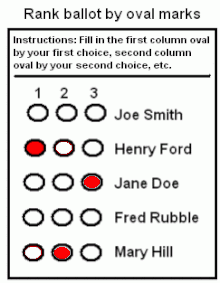 Ohio’s local elections are undemocratic. They appear democratic because all registered voters can participate, but this only means they have democratic potential. Low voter turnout, driven by apathy and ignorance, make these elections undemocratic. Are voters to blame? Somewhat. But the truth is more complicated. Our system discourages voter participation, provides voters with very little information about local candidates, and privileges the prerogatives of political parties. A ranked-choice voting system could help to make elections more democratic, but no system is truly democratic without voter participation.
Ohio’s local elections are undemocratic. They appear democratic because all registered voters can participate, but this only means they have democratic potential. Low voter turnout, driven by apathy and ignorance, make these elections undemocratic. Are voters to blame? Somewhat. But the truth is more complicated. Our system discourages voter participation, provides voters with very little information about local candidates, and privileges the prerogatives of political parties. A ranked-choice voting system could help to make elections more democratic, but no system is truly democratic without voter participation.
It’s no secret that most voters only show up for the presidential elections. According to the Montgomery County Board of Elections, in 2019 only 20.83% of the electorate showed up on election day. That means it only took 11% of the electorate to choose a winner. But the general election only tells half the story. In the primary only 9.6% of the electorate showed up. Dayton holds “jungle primaries,” which the city touts as more fair and nonpartisan. This means that the top four vote candidates advance to the general election for 2 seats and no partisan labels are attached. But let’s look at the numbers: Matt Joseph, who ended up winning a city commissioner seat, finished first in the primary with 2,405 votes. That’s 28.13% of primary voters, which is less than 2.7% of the 89,233 eligible voters in Dayton precincts. Joseph ended up winning the general election with 6,967 votes. That’s 30.63% of the vote in the general election, or 7.8% of eligible voters in all Dayton precincts.
Odd Years, Odd Elections
Why do so few voters participate in these elections? Holding them on odd-numbered years doesn’t help. Odd-year municipal elections were added to the Ohio Constitution in 1905. Ohio Revised Code 3501 provides further details. In theory, holding municipal elections on odd numbered years should increase voter participation. Without the national, state, and county elections overshadowing them, the local media should provide greater scrutiny and coverage to municipal candidates. This happens, to some extent, but primary elections do not receive the attention they deserve. Very few people pay attention and participate when the candidates are chosen in the primaries. With low voter engagement, local elections are decided by a small group of voters. Unsurprisingly, many of these participants are involved in party politics or operate businesses with political interests.
Dayton’s jungle primary places the top four candidates on the general election ballot. This somewhat alleviates the unfairness of primaries, but it’s mostly for show. In heavily Democratic Dayton, all four candidates for City Commissioner were Democrats because that’s what the jungle primary chooses (9.6% of the electorate!). It’s no wonder that people don’t bother with municipal elections when they see a one-party rule. The dearth of information leading up to the primary—about both the candidates and the primary itself—ensures that voter participation will be low. This creates a vicious cycle where voters don’t participate because of the party hegemony and lack of information, while the party hegemony and lack of information persists because voters don’t participate.
*No Primary Was Held in 2017
No Easy Solution
Would placing municipal elections on even-numbered years solve the problem? Reducing the number of elections would help—and save money—but it wouldn’t make voters more informed or motivated. Every four years the presidential election draws voters to the polls, but midterm elections show a precipitous drop in voter turnout. For example, in 2014 only about 39% of voters cast a ballot for the governor. That’s a lot more than the odd-year municipal elections, but still a pretty pathetic showing (2018 was an anomaly midterm with 55% voter participation, but this year bucks the conventional midterm trend).
And, in the presidential primary, by the time the 15 dem candidates that New Hampshire and Iowa had to choose from, got to our primary, there was only one choice left in the race. One choice isn’t any choice.
Even on the presidential years, down-ballot races are less likely to receive votes. For example, in 2016, 258,301 of 372,677 eligible voters chose a candidate for the U.S. President. That’s a turnout of 69%! For the Clerk of Courts, one of the few contested county positions, that number dropped to 236,747. 63.5% still isn’t bad. Moving down the ticket, the Justice for the Supreme Court race between Fischer and O’Donnell received 189,682 votes. Now we’re down to 50%. Since judges are not identified by party on the ballot, it makes it harder for uninformed voters to make a partisan vote.
Even with more voters participating, do they even know what they’re voting for? The “coattail effect” has long been observed, where down-ballot races are won by the party of the winning presidential or gubernatorial candidate. Is it better that a small handful of informed electors choose local candidates or large swaths who just vote according to the (D) or (R) next to a candidate’s name? Neither situation fulfills the promise of democracy. The system needs to be designed to encourage voter turnout but voters must become better informed and engaged.

Ranked Choice Voting Ballot. Image from Wikipedia.
What We Can Do
No silver bullet exists to solve the undemocratic nature of local elections but there are some steps we can take to improve things.
Implement a ranked-choice voting system with no primary.
Primaries place power in the hands of the local party rather than the people. A ranked-choice system would mean that voters choose their top candidates and rank accordingly. If your first choice receives the least amount of votes, your vote goes toward the second choice. If there is still not a candidate with over 50% of the vote, this process happens again. Not only does this eliminate the need for a primary and partisan candidates, but it allows voters to vote their conscience without considering how likely their top choice is to win. Voting for a fringe or third-party candidate will no longer be “throwing your vote away.”
Eliminate the party system.
It is not constitutional or desirable to make political parties illegal, but it is both constitutional and desirable for our political institutions to be blind to party affiliation. For local elections, this means no (D) or (R) next to candidates’ names on the ballot. A ranked-choice system would allow for the ballot to be blind to party affiliation. It would force voters to do at least some cursory research on candidates so they couldn’t rely on just voting for a party all the way down the ballot.
Pay attention!
The local media needs to do more to cover local candidates, but this will only happen if local consumers create the demand for such content. One of our goals at Reconstructing Dayton is to inform the public about local candidates.
Vote.
Without amending the Ohio State Constitution, municipal elections will continue to be held on odd years. Despite the inconvenience and lack of transparency, our only hope to reform local elections is to participate in them. Dayton’s nonpartisan blanket primary demonstrates that unconventional local electoral systems can be implemented. Now we just need one that works.
In the future we will write more about local elections and the party system. Only by staying informed can we solve local problems. Democracy doesn’t work without an informed and engaged electorate. At Reconstructing Dayton, we’re fighting to make our local government democratic in practice rather than just in name.
And, one last thing. Our elections are expensive, with all that advertising being bought in the fourth quarter. This makes life difficult for many businesses to buy critical 4th quarter advertising to drive their businesses. Why should businesses have to deal with this expensive interruption to their sales cycle? It’s time to move election day to the 4th of July- a National Patriotic holiday- and stop the insanity of campaign advertising squeezing out commerce for valuable ad space.

Hello, My Name is Elizabeth Gentner and I am the Executive Co-Lead for Rank the Vote Ohio, an organization dedicated to bringing Ranked Choice Voting to Ohioans. It looks like we have some obvious commonality and I would love to talk to you about collaborating in the future. Besh wishes to you and your endeavors. Sincerely,